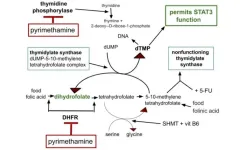(Press-News.org)
· First-of-its-kind study of immune genes in Alzheimer’s patients’ blood
· Immune T cells are altered and entering brain
· Uncertain whether changes precipitate the disease
CHICAGO --- A new Northwestern Medicine study has found the immune system in the blood of Alzheimer’s patients is epigenetically altered. That means the patients’ behavior or environment has caused changes that affect the way their genes work.
Many of these altered immune genes are the same ones that increase an individual’s risk for Alzheimer’s. Northwestern scientists theorize the cause could be a previous viral infection, environmental pollutants or other lifestyle factors and behaviors.
“It is possible that these findings implicate the peripheral immune response in Alzheimer’s disease risk,” said lead investigator David Gate, assistant professor of neurology at Northwestern University Feinberg School of Medicine. “We haven’t yet untangled whether these changes are reflective of brain pathology or whether they precipitate the disease.”
The study was published Feb. 9 in Neuron.
Previous research showed that many of the mutated genes putting a person at higher risk for Alzheimer’s are in the immune system. But scientists primarily studied the central immune system in the brain because Alzheimer’s is a brain disease. They have largely ignored the immune system in the blood, also known as the peripheral immune system.
Gate decided to study the blood. He and colleagues discovered every immune cell type in Alzheimer’s patients has epigenetic changes, indicated by open chromatin. Chromatin is the packaging of the DNA within cells. When chromatin is open — or exposed — the cells’ genome is vulnerable to alterations.
Then, Gate examined which genes are more open in these immune cells. He discovered that a receptor — CXCR3 — on the T cells was more exposed. Gate believes CXCR3 functions like an antenna on T cells that allows the cells to enter the brain. T cells do not normally enter the brain because they can cause inflammation.
“The brain is emitting a signal that it is damaged, and the T cells are homing to that signal by their antenna, CXCR3,” Gate said.
“T cells can be very toxic in the brain, but we also don’t know if these cells might be attempting to repair the damage in the brain,” Gate said.
Gate also discovered epigenetic changes in inflammatory proteins in white blood cells called monocytes.
“Altogether, these findings indicate that immune function in Alzheimer’s patients is significantly altered,” Gate said. “It could be that environmental factors, like pollutants, or infections that a person has in their lifetime cause these epigenetic changes.”
The findings revealed several genes that may be therapeutic targets for manipulating the peripheral immune system. Next steps in the research are preclinical studies using in vitro culture systems and animal models to test these targets.
Other Northwestern authors include Abhirami Ramakrishnan, Natalie Piehl, Brooke Simonton, Milan Parikh, Ziyang Zhang, Victoria Teregulova and Lynn van Olst.
The title of the article is “Epigenetic dysregulation in Alzheimer’s disease peripheral immunity.”
The research is supported by National Institute of Neurological Disorders and Stroke grant NS112458 and National Institute on Aging grant AG078713, both of the National Institutes of Health, Bright Focus Foundation, Alzheimer’s Association and Cure Alzheimer’s Fund.
END
ROCKVILLE, MD – Erdinc Sezgin, of Karolinska Institutet, Sweden will be honored as the recipient of the Biophysical Journal Paper of the Year-Early Career Investigator Award at the 68th Annual Meeting of the Biophysical Society, held February 10-14 in Philadelphia, Pennsylvania. This award recognizes the work of outstanding early career investigators in biophysics. The winning paper is titled “Influence of the Extracellular Domain Size on the Dynamic Behavior of Membrane Proteins.” The paper was published in Volume 121, Issue ...
In writing a good online dating profile, the average love-seeker is likely to fill it up with all the appealing qualities and interests that make them special. They paraglide and do hot yoga on the weekends; enjoy Riesling on the beach or seeing indie bands in basements; are a Libra with Scorpio rising; or have a dog or three kids or an iguana. There’s one thing they routinely leave out, however: what they want to know about their potential partner.
Yet, that detail might the most important thing to include, according ...
Snail shells are often colourful and strikingly patterned. This is due to pigments that are produced in special cells of the snail and stored in the shell in varying concentrations. Fossil shells, on the other hand, are usually pale and inconspicuous because the pigments are very sensitive and have already decomposed. Residues of ancient colour patterns are therefore very rare. This makes this new discovery by researchers from the University of Göttingen and the Natural History Museum Vienna (NHMW) all the more astonishing: they found pigments in ...
There are no substitutes for native vegetation, but replacing large areas of monoculture with diversified crops in places where agricultural activities are widespread can have beneficial effects on the mammals that still inhabit the region.
This is one of the conclusions of a study conducted by researchers at the University of São Paulo (USP) supported by FAPESP. They focused on the northeast of São Paulo state, where the predominant biome is the Cerrado (Brazilian savanna). The region is one of the nation’s agribusiness centers.
An article on the study is published in the Journal of Applied Ecology. The study showed that ...
Semiconductors are ubiquitous in modern technology, working to either enable or prevent the flow of electricity. In order to understand the potential of two-dimensional semiconductors for future computer and photovoltaic technologies, researchers from the Universities of Göttingen, Marburg and Cambridge investigated the bond that builds between the electrons and holes contained in these materials. By using a special method to break up the bond between electrons and holes, they were able to gain a ...
“This paper presents the rationale for adding five already approved and marketed generic drugs from general medical practice to the current standard current first line chemotherapy for pancreatic ductal adenocarcinoma (PDAC).”
BUFFALO, NY- February 9, 2024 – A new research perspective was published in Oncoscience (Volume 11) on February 7, 2024, entitled, “IPIAD- an augmentation regimen added to standard treatment of pancreatic ductal adenocarcinoma using already-marketed repurposed drugs irbesartan, pyrimethamine, itraconazole, azithromycin, and dapsone.”
In this new paper, researcher Richard E. Kast from IIAIGC Study Center presents the ...
SAN ANTONIO, Feb. 9, 2024 – The UT Health San Antonio School of Dentistry has opened a special-care dental clinic, the first of its kind in an academic setting in South Texas that will serve people of all ages with intellectual, developmental, cognitive or physical disabilities.
With spacious, specially designed treatment rooms featuring adjustable sound and lighting and even a “Zen Den” multi-sensory room to help reduce anxiety, the Phil and Karen Hunke Special Care Clinic occupies approximately ...
MIT engineers have developed a small ultrasound sticker that can monitor the stiffness of organs deep inside the body. The sticker, about the size of a postage stamp, can be worn on the skin and is designed to pick up on signs of disease, such as liver and kidney failure and the progression of solid tumors.
In an open-access study that will appear in Science Advances, the team reports that the sensor can send sound waves through the skin and into the body, where the waves reflect off internal organs and back out to the sticker. The pattern of the reflected waves can be read as ...
New Haven, Conn. — A Yale-led research team has picked a side in the “Snowball Earth” debate over the possible cause of planet-wide deep freeze events that occurred in the distant past.
According to a new study, these so-called “Snowball” Earth periods, in which the planet’s surface was covered in ice for thousands or even millions of years, could have been triggered abruptly by large asteroids that slammed into the Earth.
The findings, detailed in the journal Science Advances, may answer a question ...
Researchers have developed a sensor made from ‘frozen smoke’ that uses artificial intelligence techniques to detect formaldehyde in real time at concentrations as low as eight parts per billion, far beyond the sensitivity of most indoor air quality sensors.
The researchers, from the University of Cambridge, developed sensors made from highly porous materials known as aerogels. By precisely engineering the shape of the holes in the aerogels, the sensors were able to detect the fingerprint of formaldehyde, a common indoor air pollutant, at room temperature.
The proof-of-concept sensors, which require minimal power, could be adapted to detect ...



